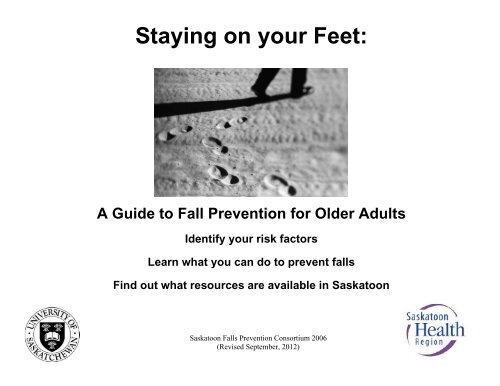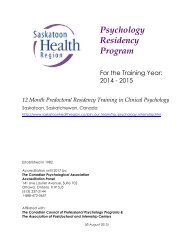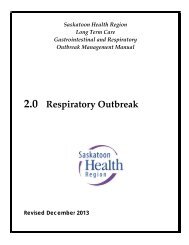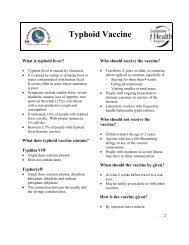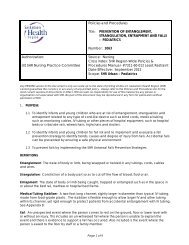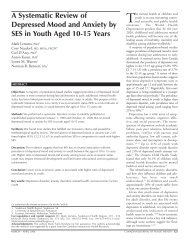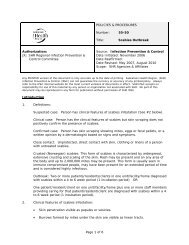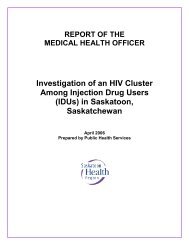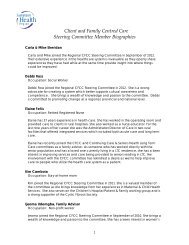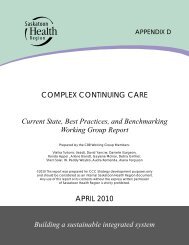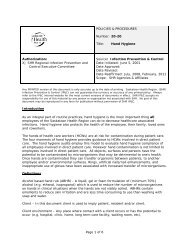Staying On Your Feet: Guide to Fall Prevention for Older Adults
Staying On Your Feet: Guide to Fall Prevention for Older Adults
Staying On Your Feet: Guide to Fall Prevention for Older Adults
You also want an ePaper? Increase the reach of your titles
YUMPU automatically turns print PDFs into web optimized ePapers that Google loves.
<strong>Staying</strong> on your <strong>Feet</strong>:<br />
A <strong>Guide</strong> <strong>to</strong> <strong>Fall</strong> <strong>Prevention</strong> <strong>for</strong> <strong>Older</strong> <strong>Adults</strong><br />
Identify your risk fac<strong>to</strong>rs<br />
Learn what you can do <strong>to</strong> prevent falls<br />
Find out what resources are available in Saska<strong>to</strong>on<br />
Saska<strong>to</strong>on <strong>Fall</strong>s <strong>Prevention</strong> Consortium 2006<br />
(Revised September, 2012)
Introduction<br />
Research shows that there are more than twenty risk fac<strong>to</strong>rs linked <strong>to</strong> falls. Most of these risks can<br />
be reduced through awareness and simple changes. This booklet will outline some risk fac<strong>to</strong>rs and<br />
things you can do <strong>to</strong> prevent falls. It suggests:<br />
What you can do<br />
Where <strong>to</strong> go<br />
Who <strong>to</strong> phone<br />
Acknowledgements<br />
We thank the Burnaby Coalition <strong>to</strong> Prevent <strong>Fall</strong>s, Fraser Health Region, <strong>for</strong> permission <strong>to</strong> modify their “Step Wise<br />
<strong>Fall</strong>s <strong>Prevention</strong> Program”.<br />
Disclaimer<br />
IMPORTANT: This material is intended <strong>to</strong> provide you with general in<strong>for</strong>mation. It does not take the place of<br />
services provided by a health care professional.<br />
2
<strong>Fall</strong> Risk Questions<br />
Do You … Circle “Yes” or “No” If “Yes” go <strong>to</strong> page…<br />
1. Ever fall because of sudden, unexpected<br />
fainting or black outs?<br />
Yes No 6 Fainting and Blackouts<br />
2. Have vision or hearing problems? Yes No 7 & 8 Vision and Hearing<br />
3. Have decreased feeling in your feet?<br />
Or<br />
Have foot problems?<br />
4. Take 3 or more prescription medications a<br />
day?<br />
Or<br />
Feel dizzy or unsteady and have had<br />
recent changes <strong>to</strong> your medications?<br />
5. Have more than one drink of alcohol in a<br />
day?<br />
6. Have recent flu symp<strong>to</strong>ms or feel unwell?<br />
Or<br />
Have health problems that limit your<br />
activity?<br />
Yes No<br />
Yes No<br />
Yes No<br />
Yes No<br />
Yes No<br />
Yes No<br />
Yes No<br />
9 Foot Problems<br />
10 Medication Use<br />
11 Alcohol Use<br />
12 Health and Wellness<br />
13 Shortness of Breath<br />
14 Osteoporosis<br />
3
<strong>Fall</strong> Risk Questions<br />
Do You … Circle “Yes” or “No” If “Yes” go <strong>to</strong> page…<br />
7. Have problems with your memory?<br />
Or<br />
Find concentrating difficult?<br />
8. Seldom check <strong>for</strong> safety hazards inside<br />
and outside your home?<br />
Yes No<br />
Yes No<br />
Yes No<br />
15 Memory<br />
16 & 17 Concentration<br />
18 & 19 Hazards Indoors<br />
20 Hazards Outdoors<br />
35 Home Safety Checklist<br />
9. Have poor eating habits? Yes No 21 Healthy Eating<br />
10. Tire easily or have leg weakness when<br />
you walk?<br />
Or<br />
Have problems or concerns getting in/out<br />
of bed, chair, tub or <strong>to</strong>ilet?<br />
Yes No<br />
Yes No<br />
22 Endurance and Weakness<br />
11. Have weak muscles or stiff joints? Yes No 23 & 24 Muscles/Joints<br />
12. Limit your activity because of pain? Yes No 25 Pain<br />
4
<strong>Fall</strong> Risk Questions<br />
Do You … Circle “Yes” or “No” If “Yes” go <strong>to</strong> page…<br />
13. Sometimes feel unsteady when you walk?<br />
Or<br />
Think your walking method puts you at<br />
risk <strong>for</strong> falling?<br />
Or<br />
Feel that you should walk more often than<br />
you do?<br />
Yes No<br />
Yes No<br />
Yes No<br />
26 Walking <strong>for</strong> Wellness<br />
14. Have <strong>to</strong> rush <strong>to</strong> the bathroom? Yes No 27 & 28 Continence<br />
15. Have trouble sleeping? Yes No 29 Sleep Difficulties<br />
16. Feel lonely or bored? Yes No 30 Seniors Centres<br />
17. Stay at home because you have no<br />
means of transportation?<br />
Yes No<br />
30 Seniors Centres - Transportation<br />
18. Have balance problems? Ever feel dizzy? Yes No 31 & 32 Balance and Dizziness<br />
19. Limit your activities due <strong>to</strong> a fear of<br />
falling?<br />
Yes No 33 Fear of <strong>Fall</strong>ing<br />
20. Have slips, trips, near falls, or falls? Yes No * Please read the complete booklet<br />
5
Fainting and Black Outs<br />
What Can Cause Fainting What you can do Who <strong>to</strong> phone, where <strong>to</strong> go<br />
A decrease in blood flow <strong>to</strong> the<br />
brain during movement.<br />
Low blood pressure.<br />
Certain medications.<br />
An inadequate diet.<br />
Low blood glucose (sugar).<br />
Rising from lying or sitting <strong>to</strong>o<br />
quickly.<br />
Fear or emotional stress (such as<br />
witnessing an emergency).<br />
Maintain a healthy diet.<br />
Drink plenty of fluids.<br />
If you are diabetic, be sure <strong>to</strong><br />
moni<strong>to</strong>r your blood glucose<br />
regularly and do not go long<br />
periods of time between meals.<br />
Take medications only as<br />
directed by your doc<strong>to</strong>r or<br />
pharmacist.<br />
Take time when rising <strong>to</strong> make<br />
sure you do not feel dizzy.<br />
Fainting and black outs can be a<br />
sign of other medical conditions,<br />
so it is important <strong>to</strong> see your<br />
family doc<strong>to</strong>r.<br />
6
What Can Cause Vision<br />
Difficulties<br />
Dirty or scratched eye glasses or<br />
sunglasses.<br />
With aging, eyes become sensitive<br />
<strong>to</strong> glaring light.<br />
Eyesight prescription has changed.<br />
Getting used <strong>to</strong> bifocals.<br />
Low lighting causes eye strain.<br />
Disease of the eye such as<br />
cataracts, glaucoma, infection.<br />
Eyes take longer <strong>to</strong> adjust from dark<br />
<strong>to</strong> light (and vice versa) as we age.<br />
Depth perception decreases with<br />
age which can make it hard <strong>to</strong> judge<br />
distances.<br />
With aging, seeing change in<br />
contrast and colour can be more<br />
difficult.<br />
Vision<br />
What you can do Who <strong>to</strong> phone, where <strong>to</strong> go<br />
Clean glasses regularly. Use a<br />
non-glare cleaner and soft cloth.<br />
Wear sunglasses outdoors.<br />
Wear special glasses that cut down<br />
on glare.<br />
Pause and give your eyes time <strong>to</strong><br />
adapt <strong>to</strong> changes in light.<br />
Increase the lighting in halls,<br />
stairways and bathrooms.<br />
Use night lights.<br />
Maintain good diabetic control.<br />
Bifocals; do not look through lower<br />
part of glasses when going up or<br />
down stairs. Bend your head <strong>to</strong> use<br />
upper part of glasses.<br />
Remove reading glasses when<br />
walking.<br />
See the eye doc<strong>to</strong>r once a year.<br />
Mark doorways and edges of steps<br />
with a brighter colour.<br />
See your local eye doc<strong>to</strong>r<br />
(Op<strong>to</strong>metrist or Ophthalmologist).<br />
Canadian Diabetes Association<br />
provides in<strong>for</strong>mation and support.<br />
Saska<strong>to</strong>on Branch Call 933-1238 or<br />
www.diabetes.ca.<br />
Canadian National Institute <strong>for</strong> the<br />
Blind provides services <strong>for</strong> people<br />
who have vision loss.<br />
Call 374-4545 or www.cnib.ca<br />
Saskatchewan Blind Sports<br />
Association.<br />
Call 975-0888.www.blindsports.ca<br />
Eye Care Centre at Saska<strong>to</strong>on City<br />
Hospital. Call 655-8000<br />
7
What Can Cause Hearing<br />
Difficulties<br />
Wax build-up in ear.<br />
Dirty hearing aids or old batteries<br />
in hearing aids.<br />
<strong>Older</strong> hearing aids, no longer<br />
appropriate <strong>for</strong> your hearing loss.<br />
Inner ear problems.<br />
Being distracted by something or<br />
not paying attention.<br />
Hearing<br />
What you can do Who <strong>to</strong> phone, where <strong>to</strong> go<br />
Make sure your ears are clear of<br />
wax.<br />
Clean your hearing aids often<br />
and check batteries regularly.<br />
In a public place, choose <strong>to</strong> sit in<br />
a quiet area of the room <strong>to</strong><br />
reduce excess noise.<br />
Reduce the number of external<br />
noises (e.g. turn the TV down<br />
when speaking on the<br />
telephone).<br />
Ask people <strong>to</strong> speak clearly and<br />
slowly. Ask the person <strong>to</strong> repeat<br />
their words if necessary.<br />
Have your hearing checked on a<br />
regular basis.<br />
Purchase a hearing aid if<br />
necessary.<br />
Speak with your family doc<strong>to</strong>r.<br />
Specialized telephone service <strong>for</strong><br />
people with hearing difficulties is<br />
available through Sask-Tel.<br />
Consult the yellow pages under<br />
Hearing Assessments and<br />
Hearing aids.<br />
For additional services contact<br />
the Sask. Deaf and Hard of<br />
Hearing Services at 665-6575<br />
(TTY: 6659845) or visit their<br />
website at www.sdhhs.com<br />
Hard of Hearing Association –<br />
Saska<strong>to</strong>on host monthly support<br />
group meetings at the<br />
Cosmopolitan Seniors Centre.<br />
8
What Can Cause Foot<br />
Difficulties<br />
Footwear that does not offer<br />
support <strong>to</strong> your feet (e.g. poorly<br />
fitting shoes or boots, slip-ons, or<br />
floppy slippers).<br />
Soles that are <strong>to</strong>o slippery or <strong>to</strong>o<br />
sticky. These soles can slip or<br />
catch on the floor.<br />
Shoes with a high or narrow heel.<br />
Untreated foot problems like<br />
calluses, bunions, untrimmed<br />
<strong>to</strong>enails or ingrown <strong>to</strong>enails.<br />
Numbness or tingling in your feet.<br />
Foot Problems<br />
What you can do Who <strong>to</strong> phone, where <strong>to</strong> go<br />
Wear proper-fitting supportive<br />
shoes with low, broad heels.<br />
Choose shoes that have a lace<br />
or velcro closure.<br />
Make sure your footwear is in<br />
good repair.<br />
Buy slippers that offer support<br />
with enclosed heels.<br />
Use a long handled shoe horn or<br />
elastic laces <strong>to</strong> help you get your<br />
shoes on.<br />
If your feet are swollen, elevate<br />
them with a pillow when sitting or<br />
lying down. <strong>Your</strong> feet should be<br />
higher than your hips.<br />
Wear loose socks that do not cut<br />
off your circulation.<br />
Ask your doc<strong>to</strong>r about wearing<br />
support socks or s<strong>to</strong>ckings.<br />
Choose a shoe s<strong>to</strong>re that offers<br />
brands made <strong>for</strong> the older foot<br />
(varied sizes, leather lining <strong>to</strong><br />
allow stretch, extra depth).<br />
Orthodedic or orthotic shoe s<strong>to</strong>res<br />
and shoe repair s<strong>to</strong>res are listed<br />
in the yellow pages.<br />
Saskatchewan Abilities Council<br />
<strong>for</strong> orthopedics 659-1694.<br />
Contact a foot doc<strong>to</strong>r (podiatrist)<br />
<strong>for</strong> hard <strong>to</strong> treat foot problems.<br />
See the yellow pages.<br />
Saska<strong>to</strong>on Health Region<br />
Podiatry 655-4130 by doc<strong>to</strong>r<br />
referral<br />
For assistance with foot care,<br />
look up Home Care Products,<br />
Elderly & Disabled in the yellow<br />
pages.<br />
Foot care providers are listed in<br />
the Council on Aging Direc<strong>to</strong>ry<br />
Call 652-2255 or www.scoa.ca<br />
9
What Can Cause Medication<br />
Concerns<br />
Taking over-the-counter (nonprescription)<br />
medications, herbal<br />
remedies or drinking alcohol with<br />
prescription medications.<br />
Using someone else’s<br />
medication.<br />
Not being sure what medications<br />
you are taking or why you need<br />
them. Not know how many pills<br />
you should take or missing a<br />
dose.<br />
Using outdated medication.<br />
<strong>Your</strong> doc<strong>to</strong>r may not be aware of<br />
all the medication you are taking.<br />
<strong>Your</strong> doc<strong>to</strong>r may not be aware of<br />
the side effects you have<br />
experienced.<br />
MYTH:<br />
“A pill will cure all ills.” More<br />
medication is not always better.<br />
Medication Use<br />
What you can do Who <strong>to</strong> phone, where <strong>to</strong> go<br />
Never borrow medication from<br />
another or lend your medication<br />
<strong>to</strong> others.<br />
Keep a list of your medications<br />
in your wallet and on the fridge.<br />
Return unused or expired<br />
medications <strong>to</strong> your pharmacist<br />
<strong>for</strong> proper disposal.<br />
Ask your pharmacist or doc<strong>to</strong>r<br />
be<strong>for</strong>e taking any over-thecounter<br />
medications or herbal<br />
remedies, with prescription<br />
medications.<br />
Avoid drinking alcohol when you<br />
are taking your medication.<br />
Review your medication with<br />
your doc<strong>to</strong>r at least every six<br />
months or if a medication is<br />
added or s<strong>to</strong>pped.<br />
Ask your pharmacist about side<br />
effects and drug interactions<br />
be<strong>for</strong>e taking any medication.<br />
Use the same pharmacy all the<br />
time.<br />
Call the pharmacist where you<br />
had your prescription filled.<br />
Speak with your family doc<strong>to</strong>r or<br />
health care professional.<br />
For in<strong>for</strong>mation about herbal,<br />
over-the-counter, and prescription<br />
medication, call the Drug<br />
In<strong>for</strong>mation Service at 966-6378,<br />
Monday <strong>to</strong> Friday or<br />
www.usask.ca/druginfo<br />
10
What Can Cause Over-Use of<br />
Alcohol<br />
Using alcohol <strong>to</strong> help you sleep.<br />
Alcohol depresses the nervous<br />
system and disturbs normal<br />
sleeping patterns.<br />
Using alcohol <strong>to</strong> relieve aches<br />
and pains. Alcohol can cause<br />
greater aches and pains.<br />
Loneliness.<br />
Sadness or depression.<br />
Grief and loss.<br />
Boredom.<br />
Stressful situations.<br />
Alcohol Use<br />
What you can do Who <strong>to</strong> phone, where <strong>to</strong> go<br />
Record how much and why you<br />
are using alcohol.<br />
Learn about how your body<br />
responds differently <strong>to</strong> alcohol<br />
with aging.<br />
Find out whether your feelings<br />
are common, so you can find<br />
healthy ways <strong>to</strong> deal with them.<br />
Share your feelings with<br />
someone you trust such as a<br />
family member, friend or health<br />
professional.<br />
If you are feeling sad or nervous,<br />
do not feel like eating or start<br />
losing interest in your activities<br />
talk with the community nurse,<br />
counsellor or your family doc<strong>to</strong>r.<br />
Join a community group or<br />
activity.<br />
Tell your doc<strong>to</strong>r about your<br />
aches and pains and discuss<br />
ways <strong>to</strong> manage the problem.<br />
Talk with support groups that are<br />
trained <strong>to</strong> counsel on alcohol<br />
misuse.<br />
Alcoholics Anonymous 665-6727<br />
Al-Anon Saska<strong>to</strong>on 665-3838<br />
Calder Centre 655-4500<br />
Mental Health and Addiction<br />
Services, Community Addiction<br />
Service 655-4100<br />
Métis Addiction Council of SK<br />
652-8951.<br />
11
Health and Wellness<br />
Health and <strong>Fall</strong> Risk What you can do Who <strong>to</strong> phone, where <strong>to</strong> go<br />
A change in your health can lead<br />
<strong>to</strong> a fall.<br />
Recent flu-like symp<strong>to</strong>ms or<br />
feeling unwell can make you feel<br />
weaker and limit your activity.<br />
This increases the risk of falling.<br />
Bladder infections may present<br />
with flu like symp<strong>to</strong>ms and can<br />
place you at risk of falls.<br />
Conditions that cause dizziness,<br />
loss of consciousness, heart<br />
problems and mobility changes<br />
can cause falls.<br />
Medical conditions that cause<br />
falls can often be treated.<br />
Bone and muscle changes as you<br />
age. <strong>Fall</strong>s can do more damage<br />
<strong>to</strong> them or cause broken bones.<br />
Medication can cause you <strong>to</strong> feel<br />
dizzy or unsteady.<br />
Book regular check-ups with<br />
your family doc<strong>to</strong>r.<br />
Make sure you know the proper<br />
dose and know how <strong>to</strong> take your<br />
medication correctly.<br />
Ask your doc<strong>to</strong>r or pharmacist <strong>to</strong><br />
review all your drugs yearly, or<br />
with any change in your health.<br />
See your eye doc<strong>to</strong>r once a year<br />
or if you notice vision changes.<br />
Eat well, follow Canada’s Food<br />
<strong>Guide</strong> <strong>for</strong> Healthy Eating.<br />
Walk and keep active every day.<br />
Talk <strong>to</strong> your family doc<strong>to</strong>r or<br />
pharmacist about any medical<br />
concerns you have or any side<br />
effects.<br />
Live Well TM with Chronic<br />
Conditions, Self-Management<br />
Program. Call 655-4437 <strong>to</strong><br />
register <strong>for</strong> a class.<br />
www.saska<strong>to</strong>onhealthregion.ca<br />
<strong>Staying</strong> on <strong>Your</strong> <strong>Feet</strong> , falls<br />
prevention program<br />
Call 655-7874<br />
Forever…in motion is an older<br />
adult physical activity group led<br />
by trained peer- leaders. Call<br />
655-0829<br />
<strong>Older</strong> Adult Wellness Nurse offers<br />
group education and written<br />
in<strong>for</strong>mation on health and lifestyle.<br />
Call 655-4299<br />
Review the Canada Food <strong>Guide</strong><br />
www.hc-sc.gc.cahp<br />
12
What Can Cause Shortness of<br />
Breath<br />
Smoking<br />
Lack of physical activity<br />
Obesity<br />
Pollution<br />
Lung infection<br />
Chronic disease such as<br />
bronchitis, emphysema and<br />
COPD<br />
Allergies and asthma<br />
Heart problems<br />
Shortness of Breath<br />
What you can do Who <strong>to</strong> phone, where <strong>to</strong> go<br />
Cut down or s<strong>to</strong>p smoking with<br />
help from family, friends and<br />
education programs.<br />
Try <strong>to</strong> stay away from places<br />
where air is polluted (e.g.<br />
smoking areas).<br />
Get your annual flu shot and<br />
pneumonia vaccine <strong>to</strong> prevent<br />
severe lung infections.<br />
Gradually increase your physical<br />
activity. Walk with a friend or join<br />
a fitness group.<br />
Eat healthy meals.<br />
Speak with your doc<strong>to</strong>r about<br />
shortness of breath and why it is<br />
occurring. Note when it happens<br />
and how it limits your activities.<br />
Balance activity, exercise and<br />
rest. Pace yourself.<br />
Try <strong>to</strong> limit outdoor activities<br />
during a poor air quality warning.<br />
Lung Association of SK has<br />
in<strong>for</strong>mation <strong>to</strong> help people with<br />
lung problems. Call 343-9511 or<br />
www.sk.lung.ca<br />
•Community Asthma Educa<strong>to</strong>r:<br />
Asthma in<strong>for</strong>mation line: 1-800-566<br />
5864.<br />
Saska<strong>to</strong>on Health Region, Live<br />
Well TM with Chronic Disease<br />
Management Program offers<br />
exercise and education. Call 655-<br />
3483 <strong>for</strong> in<strong>for</strong>mation. A doc<strong>to</strong>r’s<br />
referral is required.<br />
For help on how <strong>to</strong> s<strong>to</strong>p smoking<br />
Call:<br />
Smoker’s Helpline<br />
1-877-513-5333<br />
Canadian Cancer Society<br />
244-4389 or visit<br />
www.cancer.ca<br />
13
Osteoporosis and Bone Health<br />
What Can Cause Osteoporosis What you can do Who <strong>to</strong> phone, where <strong>to</strong> go<br />
Bones naturally become less<br />
dense and weaker with age.<br />
Lack of exercise and poor<br />
nutrition can worsen bone loss.<br />
Osteoporosis is a disease that<br />
causes loss of bone mass. This<br />
leads <strong>to</strong> brittle bones and risk <strong>for</strong><br />
fracture.<br />
Causes include:<br />
A diet low in calcium or Vitamin D<br />
Low body weight<br />
Decreased activity<br />
High salt diet<br />
Advanced age<br />
Cigarette smoking<br />
Early menopause<br />
Excess caffeine intake (greater<br />
than 2 cups of coffee per day)<br />
Alcohol use<br />
Decrease in estrogen in women<br />
Choose 4 servings of dairy<br />
products per day (1500 mg):<br />
1 serving =<br />
• 1 cup of milk,<br />
• ¾ cup of yogurt<br />
• 2 oz. of cheese<br />
Take calcium 1500 mg and<br />
Vitamin D supplement of 800 IU.<br />
Eat three balanced meals every<br />
day. For more in<strong>for</strong>mation consult<br />
the Canada Food <strong>Guide</strong>. See<br />
page 21.<br />
Choose foods from each of the<br />
four food groups.<br />
Get active. Weight bearing<br />
exercise builds strong bones.<br />
If you drink alcohol, consume no<br />
more than two servings per day.<br />
S<strong>to</strong>p smoking.<br />
A registered dietitian can be<br />
contacted at 655-4260 <strong>for</strong><br />
nutrition and diet counselling.<br />
Meals on Wheels: call 655-4318<br />
<strong>to</strong> have a hot lunch delivered <strong>to</strong><br />
your home.<br />
Some private services will<br />
prepare meals <strong>for</strong> you. Look up<br />
Home Care Disabled & Elderly<br />
Persons in the yellow pages.<br />
Osteoporosis Canada,<br />
Saska<strong>to</strong>on Chapter provides<br />
in<strong>for</strong>mation #1-324 Packham Ave<br />
or call 931-2663 or<br />
www.osteoporosis.ca<br />
Consider an exercise class<br />
specific <strong>for</strong> osteoporosis:<br />
Cosmo Civic Centre 975-3344<br />
SAFE Senior Aquatic and<br />
Fitness Exercise at Lawson<br />
Civic Centre 975-7873<br />
Osteoporosis Exercise Program<br />
at Saska<strong>to</strong>on Field House<br />
975-3121<br />
14
Memory<br />
What Can Cause Memory Loss What you can do Who <strong>to</strong> phone, where <strong>to</strong> go<br />
Normal aging can lead <strong>to</strong> more<br />
difficulty <strong>to</strong> learn new material. It<br />
may take a longer time <strong>to</strong> recall<br />
what was learned . Aging should<br />
not lead <strong>to</strong> dramatic memory<br />
loss.<br />
Causes of memory loss:<br />
Depression<br />
Illnesses and infection<br />
Dementia (including Alzheimer’s<br />
disease)<br />
Side effects of some medication<br />
Stroke<br />
Brain injury or brain tumour<br />
Excessive alcohol consumption<br />
Make a list.<br />
Follow a daily routine.<br />
Keep a detailed calendar.<br />
Make associations <strong>to</strong> help you<br />
remember (such as using<br />
landmarks <strong>to</strong> help you find<br />
places).<br />
Put important items in the same<br />
place every time (such as your<br />
keys).<br />
Repeat the name of a new<br />
person that you meet.<br />
Keep your mind and body active.<br />
Do puzzles and play games <strong>to</strong><br />
keep your mind sharp.<br />
Talk <strong>to</strong> your family doc<strong>to</strong>r about<br />
whether your memory loss is<br />
normal or needs <strong>to</strong> be assessed.<br />
15
What Can Cause Difficulties with<br />
Concentration<br />
Chronic pain.<br />
Continually feeling rushed or<br />
stressed.<br />
Fear of falling.<br />
Worrying about poor memory or<br />
memory gaps.<br />
Poor appetite or not eating<br />
balanced meals.<br />
Feeling nervous or anxious.<br />
Feeling sad, lonely or depressed.<br />
Not keeping mentally active.<br />
Concentration Difficulties<br />
What you can do Who <strong>to</strong> phone, where <strong>to</strong> go<br />
Plan ahead and be organized.<br />
Write down activities that need <strong>to</strong><br />
be done during the day. Keep a<br />
journal or use a calendar <strong>to</strong><br />
remind yourself of upcoming<br />
events. Make a list. Keep items<br />
in the same place.<br />
Eat regularly <strong>to</strong> prevent physical<br />
weakness and mental<br />
sluggishness.<br />
Stay active both physically and<br />
mentally. “Use it or Lose it”.<br />
Counselling services are<br />
available through any agencies:<br />
Adult Community Mental<br />
Health Services, Saska<strong>to</strong>on<br />
Health Region 655-7950<br />
Family Services Saska<strong>to</strong>on<br />
244-0127<br />
Catholic Family Services of<br />
Saska<strong>to</strong>on 244-7773<br />
Clinical Health Psychology,<br />
Royal University Hospital<br />
655-2341<br />
Client Patient Access<br />
Services (CPAS)can refer<br />
you <strong>to</strong> a community social<br />
worker or occupational<br />
therapist. Call 655-4346<br />
Canadian Mental Health<br />
Association 384-9333.<br />
Join a Senior’s Centre <strong>to</strong> keep<br />
both your mind and body active.<br />
See page 30.<br />
Alzheimer’s Society provides<br />
education, respite and caregiver<br />
support groups: Call 683-6322.<br />
16
What Can Cause Difficulties with<br />
Concentration<br />
Grief and loss.<br />
Medications (some examples are<br />
sleeping pills or pills <strong>for</strong> anxiety).<br />
Not exercising your brain.<br />
Alcohol use.<br />
Concentration Difficulties<br />
What you can do Who <strong>to</strong> phone, where <strong>to</strong> go<br />
Talk with someone you can trust<br />
about feeling anxious or sad.<br />
Learn relaxation techniques.<br />
Speak with your doc<strong>to</strong>r about<br />
any recent loss of appetite, loss<br />
of interest in activities, difficulty<br />
sleeping or sleeping <strong>to</strong>o much,<br />
discom<strong>for</strong>t, or difficulty in<br />
remembering things.<br />
Mental exercises such as<br />
crossword puzzles or playing<br />
games. Keep your mind active.<br />
Join community organizations.<br />
Volunteer in your community.<br />
SK Brain Injury Association. Call<br />
373-1555<br />
Heart and Stroke Foundation, call<br />
244-2124 or visit their website<br />
www.heartandstroke.sk.ca<br />
17
What Can Be Hazardous in and<br />
Around the Home<br />
Rushing <strong>to</strong> answer the door,<br />
phone, or <strong>to</strong> use the bathroom.<br />
Slippery floors and hallways.<br />
Poor lighting when getting up at<br />
night.<br />
Glare or poor lighting.<br />
Clutter (phone or electrical cords,<br />
shoes, pet dishes, papers, or<br />
anything you may trip on).<br />
Slipping in tub or shower.<br />
Uneven walk ways in patios,<br />
entrances, garages, sidewalks,<br />
and gardens.<br />
Loose carpets or scatter rugs.<br />
Stairs and bathrooms without<br />
secure grab bars.<br />
Hazards Indoors<br />
What you can do Who <strong>to</strong> phone, where <strong>to</strong> go<br />
Use a cordless or cellular phone.<br />
Wipe up spills right away.<br />
Install a night light close <strong>to</strong> the<br />
bathroom, near the bed, and in<br />
the hallways. Use a commode at<br />
night if necessary.<br />
Keep your home free from<br />
clutter.<br />
Use non-slip mats in bathrooms<br />
and in the tub.<br />
Fix or mark uneven floors.<br />
Tack down all carpets. Remove<br />
scatter rugs.<br />
Install handrails <strong>for</strong> all stairs<br />
inside and outside the home.<br />
Occupational therapist can<br />
conduct a home safety visit. See<br />
Occupational Therapy in the<br />
yellow pages.<br />
Check the yellow pages under<br />
Medical Equipment and Supplies,<br />
or Home Care Products Elderly &<br />
Disabled.<br />
Saskatchewan Abilities Council<br />
653-1694 or<br />
www.abilitiescouncil.sk.ca<br />
Mobility aids and special needs<br />
equipment are available through<br />
loan by the Saskatchewan Aids <strong>to</strong><br />
Independent Living program.<br />
Call (306) 787-7121 or 1-800-667-<br />
7766 or visit their website<br />
www.health.gov.sk.ca/ps_sail.html<br />
To get an emergency bracelet,<br />
watch or pendant contact Philips<br />
Lifeline ® at 1-866-784-1992<br />
www.lifeline.ca<br />
18
What Can Be Hazardous in and<br />
Around the Home<br />
Using <strong>to</strong>wel racks <strong>for</strong> support.<br />
Bending over <strong>to</strong> reach low<br />
objects.<br />
Standing on a ladder or chair <strong>to</strong><br />
reach high objects.<br />
Clothing that is <strong>to</strong>o long (e.g.<br />
nightgowns, dressing gowns,<br />
baggy pants).<br />
Poor furniture arrangement and<br />
not having enough space <strong>to</strong> walk<br />
or use a walker.<br />
Pets and their <strong>to</strong>ys.<br />
Hazards Indoors<br />
What you can do Who <strong>to</strong> phone, where <strong>to</strong> go<br />
Install grab bars in the bathroom.<br />
Buy a long-handle reacher<br />
Do not stand on ladders, chairs<br />
or s<strong>to</strong>ols. S<strong>to</strong>re items where they<br />
are easy <strong>to</strong> reach.<br />
Wear proper fitting clothing and<br />
supportive footwear.<br />
Take your time when carrying<br />
objects. Use a stroller or your<br />
walker <strong>to</strong> carry items.<br />
Rearrange your furniture <strong>to</strong> open<br />
up the space. This is especially<br />
important if using walking aids.<br />
Watch out <strong>for</strong> sleeping pets. Pick<br />
up their <strong>to</strong>ys so that you do not<br />
trip on them.<br />
Some private companies will<br />
assist with home cleaning and<br />
reorganization. Consult the yellow<br />
pages under Home Care<br />
Disabled & Elderly Persons, or<br />
Maid Service.<br />
Grants <strong>for</strong> minor safety<br />
renovations are available through<br />
the Home Adaptations <strong>for</strong><br />
Seniors’ Independence program<br />
Call the Canadian Mortgage and<br />
Housing Corporation at 975-4900<br />
or 1-866-245-5758 or<br />
www.cmhc-schl.gc.ca/<br />
en/co/prfinas/prfinas004.cfm<br />
*See page 36 <strong>for</strong> a home safety<br />
checklist.<br />
19
What Can Be Hazardous<br />
Outdoors<br />
Walking in unfamiliar<br />
environments.<br />
Wet leaves, fallen branches,<br />
snow, ice or water puddles on the<br />
street or sidewalks.<br />
Raised or cracked sidewalks.<br />
Improper footwear <strong>for</strong> the type of<br />
weather.<br />
Poor outdoor lighting.<br />
Unmarked curbs or changes in<br />
street levels, speed bumps.<br />
Being knocked or bumped in<br />
crowded public areas, (malls,<br />
parks and event centres).<br />
Rushing and not paying attention.<br />
Getting on or off buses.<br />
Hazards Outdoors<br />
What you can do Who <strong>to</strong> phone, where <strong>to</strong> go<br />
Walk slowly and pay attention.<br />
Avoid walking on wet leaves,<br />
snow or ice if possible or walk<br />
slowly with caution.<br />
Use walking aids as<br />
recommended by a health care<br />
professional.<br />
Keep your centre of gravity over<br />
your feet and avoid reaching or<br />
twisting when walking or<br />
standing.<br />
Use a waist belt pack or<br />
backpack instead of carrying a<br />
purse.<br />
Use a portable,folding grocery<br />
cart instead of carrying heavy<br />
bags.<br />
Install au<strong>to</strong>matic or timed lighting<br />
outside.<br />
Be aware of other people in<br />
crowded places. Try <strong>to</strong> avoid<br />
situations where you may be<br />
bumped.<br />
Using a cane or walking aid may<br />
alert other walkers <strong>to</strong> allow you<br />
more space.<br />
Contact the City of Saska<strong>to</strong>on if<br />
you notice any safety problems<br />
with the following:<br />
Property Maintenance<br />
975-2828<br />
Street and Sidewalk<br />
Maintenance 975-2476<br />
Street Light Maintenance<br />
975-2414<br />
When you call, report:<br />
Location of the hazard<br />
Description of the hazard<br />
If you have fallen because of the<br />
hazard<br />
20
Balanced, Healthy Eating <strong>for</strong> Seniors<br />
What is Healthy Eating?<br />
Eat enough calories <strong>to</strong> maintain a healthy body<br />
weight. If you are unsure if your weight is healthy,<br />
ask your doc<strong>to</strong>r at your next appointment.<br />
Eat 3 balanced meals a day. If your appetite is small,<br />
try adding snacks or nutritional drinks (Boost® or<br />
Ensure®) between meals.<br />
Drink 6-8 cups of non-caffeinated fluids per day <strong>to</strong><br />
stay hydrated.<br />
Choose foods high in fibre at each meal <strong>to</strong> help<br />
maintain regular bowel movements. Foods high in<br />
fibre include: whole grain breads, pastas and cereals,<br />
fruits, vegetables, beans and lentils.<br />
Take steps <strong>to</strong> enjoy meals and snacks with family<br />
and friends. Use Canadian Good <strong>Guide</strong> <strong>to</strong> help you:<br />
www.hc-sc.gc.ca/fn-an/food-guide-aliment/indexeng.php<br />
What is a Balanced Meal?<br />
A balanced meal follows: Eating Well with Canada’s<br />
Food <strong>Guide</strong><br />
Include foods from each food group at each meal.<br />
Food groups are shown in the Food <strong>Guide</strong>’s rainbow.<br />
Other Tips<br />
Most adults over the age of 50 years benefit from taking a multivitamin with minerals “<strong>for</strong> older adults” daily.<br />
Incorporate 30 minutes of activity daily. Include flexibility, strength and balance and endurance exercises. If your<br />
activity level has altered recently, speak with your doc<strong>to</strong>r about available options <strong>to</strong> maximize safe activity.<br />
*If you are concerned about nutrition, speak with your doc<strong>to</strong>r <strong>to</strong> see if a referral <strong>to</strong> a dietician is appropriate.<br />
21
What Can Cause Low Endurance<br />
and Weakness<br />
Decreased level of physical<br />
activity: “use it or lose it”.<br />
Not eating regularly: proper<br />
nutrition is important <strong>to</strong> maintain<br />
your energy and strength.<br />
Heart and lung problems can lead<br />
<strong>to</strong> shortness of breath and fatigue<br />
during activity.<br />
Neurological conditions can affect<br />
the way your muscles function<br />
and affect your activity levels.<br />
Arthritis pain and stiff joints can<br />
limit your daily activities.<br />
Endurance and Weakness<br />
What you can do Who <strong>to</strong> phone, where <strong>to</strong> go<br />
Gradually increase the amount<br />
of physical activity you do each<br />
day.<br />
Keep active <strong>to</strong> maintain your<br />
strength, flexibility, and<br />
endurance.<br />
Consult your doc<strong>to</strong>r be<strong>for</strong>e<br />
beginning a fitness routine.<br />
Use appropriate aids<br />
recommended by a health care<br />
professional <strong>to</strong> help decrease<br />
the energy required <strong>to</strong> complete<br />
daily tasks.<br />
Take appropriate rest periods<br />
between activities; don’t try <strong>to</strong> do<br />
it all at once!<br />
Prioritize. Limit unnecessary<br />
tasks <strong>to</strong> make sure you have<br />
enough energy <strong>for</strong> the things you<br />
need and want <strong>to</strong> do.<br />
Ask <strong>for</strong> assistance when lifting or<br />
moving heavy objects.<br />
Get assistance with heavy tasks<br />
such as house cleaning, cutting<br />
grass, shovelling snow, etc.<br />
Sit on higher chairs or ones that<br />
have armrests <strong>to</strong> make it easier<br />
<strong>to</strong> get up from sitting.<br />
Refer <strong>to</strong> Canada’s Activity <strong>Guide</strong><br />
<strong>for</strong> <strong>Older</strong> <strong>Adults</strong> available at<br />
www.paguide.com or call<br />
1-888-334-9769<br />
Contact in motion <strong>for</strong> your copy<br />
of Physical Activity and Healthy<br />
Eating Resources <strong>for</strong> <strong>Older</strong><br />
<strong>Adults</strong> 655-DOIT (3648) or<br />
www.in-motion.ca<br />
Arrange <strong>for</strong> an assessment with<br />
Client/Patient Access Services<br />
(CPAS) <strong>to</strong> assess and refer <strong>to</strong><br />
community physical and<br />
occupational therapy 655-4346.<br />
Contact Saska<strong>to</strong>on Services <strong>for</strong><br />
Seniors at 668-2762 <strong>for</strong> home<br />
help.<br />
22
What Can Cause Weak<br />
Muscles and Stiff Joints<br />
Decrease in physical activity.<br />
Untreated injury, pain or<br />
discom<strong>for</strong>t.<br />
Conditions affecting the<br />
muscles and joints (arthritis,<br />
osteoporosis, MS,<br />
Parkinson’s, and stroke).<br />
Tight muscles.<br />
Overdoing physical activity.<br />
Muscles and Joints<br />
What you can do Who <strong>to</strong> phone, where <strong>to</strong> go<br />
Join an exercise program at<br />
recreational centres or seniors<br />
centres.<br />
Plan a regular physical activity<br />
and gradually increase it.<br />
See a physiotherapist or<br />
kinesiologist <strong>for</strong> exercises<br />
designed <strong>for</strong> you.<br />
Talk with your health<br />
professional (your doc<strong>to</strong>r, a<br />
physiotherapist, occupational<br />
therapist, or exercise<br />
physiologist) about your<br />
discom<strong>for</strong>t or soreness. It’s a<br />
good idea <strong>to</strong> write down what<br />
time of day it comes, what<br />
activity you are doing, when the<br />
discom<strong>for</strong>t is the worst, and what<br />
you do <strong>to</strong> relieve the pain.<br />
Seniors’ Centers offer a variety of<br />
social and exercise programs. See<br />
page 30 <strong>for</strong> these contacts.<br />
Private physiotherapy clinics are<br />
listed in the Yellow Pages. No<br />
referral is required. You may wish <strong>to</strong><br />
discuss with your doc<strong>to</strong>r be<strong>for</strong>e<br />
making an appointment because<br />
there may be a fee.<br />
Check the City of Saska<strong>to</strong>on Leisure<br />
<strong>Guide</strong> <strong>for</strong> in<strong>for</strong>mation on gentle<br />
fitness. It is available at all City of<br />
Saska<strong>to</strong>on Leisure facilities or<br />
www.saska<strong>to</strong>on.ca<br />
CPAS can refer <strong>to</strong> Community<br />
Therapy <strong>for</strong> those who are unable <strong>to</strong><br />
attend rehabilitation as an outpatient<br />
655-4346.<br />
Call Forever… in motion 655-0829.<br />
Masters Swimming: contact Gisele<br />
at 242-9092 or ggignac@sasktel.net<br />
23
Muscles and Joints<br />
What Can Cause Weak Muscles<br />
and Stiff Joints<br />
What you can do Who <strong>to</strong> phone, where <strong>to</strong> go<br />
Arthritis Arthritis Society gives assistance Registered massage therapists<br />
<strong>to</strong> find local community<br />
resources, guidance <strong>to</strong> access<br />
are listed in the Yellow Pages.<br />
the health care system, and Forever In Motion<br />
emotional support.<br />
Toll free 1-800-321-1433<br />
655-DOIT(3648)<br />
Contact Arthritis Society<br />
244-4755 or www.arthritis.ca.<br />
They offer programs including:<br />
‘Twinges ‘n Hinges’ swimming<br />
program at YWC. Call<br />
244-0944<br />
People with Arthritis Can<br />
Exercise. Drop in program<br />
(PACE) Call 1-800-321-1433<br />
See Walking <strong>for</strong> Wellness (p. 26)<br />
<strong>for</strong> walking programs<br />
Bridge City Senior Action,<br />
Saska<strong>to</strong>on Field House call<br />
975-3354 <strong>for</strong> contact in<strong>for</strong>mation<br />
SAFE: Senior Aquatic and<br />
Fitness Exercise at Lawson Civic<br />
Centre 975-7873<br />
Live Well with Chronic Disease<br />
Management – 655-LIVE (5483)<br />
24
Pain<br />
What Can Cause Pain What you can do Who <strong>to</strong> phone, where <strong>to</strong> go<br />
A recent injury, surgery, or<br />
illness.<br />
A chronic disease such as<br />
arthritis, diabetes, or MS.<br />
Pain can be worsened by<br />
emotions such as fear, stress,<br />
anxiety, and depression.<br />
Take your time and be careful so<br />
you can avoid injury.<br />
Stand, sit, and walk with good<br />
posture.<br />
Maintain an active and healthy<br />
lifestyle <strong>to</strong> decrease the chance<br />
of developing chronic illness.<br />
Keep a diary of your pain.<br />
Record when your pain<br />
happens, what activities cause it,<br />
what relieves your pain, and how<br />
strong your pain is (on a scale of<br />
1 <strong>to</strong>10). Take this pain diary<br />
with you <strong>to</strong> health appointments.<br />
Learn relaxation techniques <strong>to</strong><br />
help decrease your emotional<br />
response <strong>to</strong> pain.<br />
If your pain is due <strong>to</strong> muscle<br />
soreness, consider visiting a<br />
massage therapist.<br />
Consult a physical therapist or<br />
family doc<strong>to</strong>r about the<br />
appropriate use of cold or heat<br />
therapy.<br />
See your family doc<strong>to</strong>r about any<br />
pain that does not go away, or if it<br />
comes and goes but does not<br />
improve over time. A referral <strong>to</strong><br />
the Chronic Pain Centre may be<br />
helpful.<br />
If your pain is due <strong>to</strong> an injury,<br />
see your family doc<strong>to</strong>r and/or<br />
physical therapist <strong>to</strong> treat the<br />
injury.<br />
Talk <strong>to</strong> your pharmacist or family<br />
doc<strong>to</strong>r about what sort of pain<br />
medication is appropriate <strong>for</strong> your<br />
pain.<br />
Many people find acupuncture<br />
useful in decreasing pain. Look<br />
<strong>for</strong> Acupuncture in the yellow<br />
pages.<br />
To find a massage therapist look<br />
up Massage in the yellow pages.<br />
25
Walking <strong>for</strong> Wellness<br />
What Can Limit <strong>Your</strong> Walking What you can do Who <strong>to</strong> phone, where <strong>to</strong> go<br />
Review your identified risk fac<strong>to</strong>rs Walk with a friend.<br />
Aqua Walking<br />
on pages 3, 4, and 5.<br />
Harry Bailey Aquatic Centre<br />
Understand what you can do <strong>for</strong> Walk in your neighbourhood.<br />
975-3321<br />
each risk fac<strong>to</strong>r.<br />
Lakewood Civic Centre<br />
Walk in different places such as 975-2944<br />
Myth: “No pain, go gain”<br />
tennis courts, libraries,<br />
museums, malls, etc.<br />
Shaw Centre 975-7744<br />
Walking Programs<br />
Listen <strong>to</strong> your body. S<strong>to</strong>p your<br />
activity if you experience pain<br />
or discom<strong>for</strong>t.<br />
Walk in a pool <strong>to</strong> ease joint pain.<br />
Use a walking aid if you are<br />
unsteady (like a cane or walking<br />
poles).<br />
Pedestrian Walking Club<br />
244-0957<br />
Mall Walking Program, call the<br />
Saskatchewan Senior’s<br />
Fitness Association<br />
Join a walking program. Be<strong>for</strong>e<br />
starting a walking routine, speak<br />
with your family doc<strong>to</strong>r.<br />
242-9452<br />
Gentle Walk and Talk<br />
Saska<strong>to</strong>on Field House<br />
975-3354<br />
Start slowly and progress<br />
slowing.<br />
Summer Walking Group,<br />
Cosmopolitan Senior’s Centre<br />
652-9766<br />
Walk everyday because you are<br />
worth it.<br />
Walk & Sculpt, Lakewood<br />
Civic Centre 975-7808<br />
Walking Track at Shaw Centre<br />
975-7744<br />
Walking Track at the Terry Fox<br />
Track 657-5757<br />
26
What Can Cause Changes in<br />
Bladder & Bowel Control<br />
Normal aging can cause bladder<br />
size <strong>to</strong> hold less urine.<br />
Urinary bladder infection<br />
Weakness of muscles controlling<br />
urine flow<br />
Side effects of medication<br />
Prostate problems<br />
Constipation<br />
Irritants such as caffeine, alcohol,<br />
carbonated beverages<br />
Not drinking enough fluids<br />
Difficulty getting <strong>to</strong> the bathroom<br />
on time<br />
Damaged muscle (from childbirth<br />
or surgery e.g. prostate or<br />
bladder surgery) can cause<br />
incontinence with coughing or<br />
sneezing.<br />
Continence<br />
What you can do Who <strong>to</strong> phone, where <strong>to</strong> go<br />
Talk <strong>to</strong> your doc<strong>to</strong>r.<br />
Go <strong>to</strong> the bathroom be<strong>for</strong>e going<br />
<strong>to</strong> bed or leaving the house.<br />
Limit or avoid beverages with<br />
caffeine<br />
Avoid constipation by eating a<br />
high fibre diet, drinking plenty of<br />
fluids, and exercise.<br />
Talk <strong>to</strong> your doc<strong>to</strong>r or health<br />
professional about treatment and<br />
exercises that strengthen the<br />
muscles that control urine flow.<br />
Drink enough fluids so your urine<br />
is light yellow in color.<br />
See your doc<strong>to</strong>r about any<br />
changes in bowel or bladder<br />
control, blood in urine, foul<br />
smelling urine, difficulty or pain<br />
urinating, getting <strong>to</strong> the<br />
bathroom on time, constipation<br />
or diarrhea.<br />
Install a properly secured grab<br />
bar by the <strong>to</strong>ilet <strong>for</strong> support<br />
getting up from or down <strong>to</strong> the<br />
<strong>to</strong>ilet.<br />
Canadian Continence Foundation<br />
Call 1-800-265-9575 or visit<br />
www.continence-fdn.ca<br />
Kidney Foundation of Canada<br />
Disability Strategy – 664-8588<br />
www.kidney.sk.ca<br />
Pelvic Floor Rehab, Saska<strong>to</strong>on<br />
Health Region 655-6208<br />
Daniels Kimber Physiotherapy<br />
(bladder control) 652-5151<br />
Life Mark Health Center 304-3907<br />
Community Clinic PT 652-0300<br />
Erindale Physical Rehab 664-<br />
7275<br />
Bourassa & Associates 650-1962<br />
Dietitian Saska<strong>to</strong>on Health<br />
Region 655-4265<br />
Speak with your family doc<strong>to</strong>r or a<br />
health care professional.<br />
27
What Can Cause Changes in<br />
Bladder & Bowel Control<br />
Constipation can make your<br />
bladder problems worse. If the<br />
rectum is filled with constipated<br />
s<strong>to</strong>ol, there is less room <strong>for</strong> the<br />
bladder <strong>to</strong> fill. You should have<br />
regular, soft, <strong>for</strong>med bowel<br />
movements (at least every three<br />
days).<br />
Chronic Diseases<br />
Diabetes<br />
Stroke<br />
Dementia<br />
Continence<br />
What you can do Who <strong>to</strong> phone, where <strong>to</strong> go<br />
If you are on regular narcotic pain<br />
medication, you will need regular<br />
laxatives.<br />
Try <strong>to</strong> keep blood sugars under<br />
good control. High blood sugars<br />
can make increase the chance of<br />
getting a bladder infection.<br />
Wear loose fitting or modified<br />
clothing (i.e. velcro instead of<br />
but<strong>to</strong>ns or zippers, elastic<br />
waistband instead of a belt).<br />
You may need <strong>to</strong> be reminded <strong>to</strong><br />
go <strong>to</strong> the <strong>to</strong>ilet regularly if you<br />
cannot feel the urge <strong>to</strong> go, <strong>for</strong><br />
yourself.<br />
Visit your local drug s<strong>to</strong>re,<br />
medical supply s<strong>to</strong>re or<br />
pharmacy <strong>for</strong> continence<br />
products (e.g. pads, bed sheets,<br />
condom catheters, urinals, etc.).<br />
28
What Can Cause Difficulties with<br />
Sleeping<br />
Lack of physical activity.<br />
Poor sleeping environment<br />
(temperature of the room, noise,<br />
uncom<strong>for</strong>table bed).<br />
Lack of sunlight in the daytime.<br />
Having caffeinated drinks in the<br />
evening (coffee, tea, cola, alcohol<br />
or chocolate).<br />
Napping in the late afternoon and<br />
early evening.<br />
Stress.<br />
Feeling nervous, anxious,<br />
depressed or worried.<br />
Alcohol use.<br />
Medication.<br />
In<strong>to</strong>lerance <strong>to</strong> sleeping pills.<br />
Aches and pains.<br />
Grief and loss.<br />
Sleep apnea.<br />
Sleep Difficulties<br />
What you can do Who <strong>to</strong> phone, where <strong>to</strong> go<br />
Normal sleeping pattern <strong>for</strong> older<br />
adults is six hours per night,<br />
awakening twice during the<br />
night, falling asleep again within<br />
20 min.<br />
If you can’t sleep after 20-40<br />
minutes, try reading or listening<br />
<strong>to</strong> music.<br />
Avoid caffeinated foods and<br />
drinks late in the day, try warm<br />
milk instead.<br />
Do not nap in the late afternoon<br />
or early evening.<br />
Keep bedroom cool and quiet.<br />
Learn relaxation techniques.<br />
Use sleeping pills only if<br />
necessary, and contact your<br />
doc<strong>to</strong>r be<strong>for</strong>e using.<br />
Exercise during the day.<br />
Limit alcohol. It helps you go <strong>to</strong><br />
sleep, but reduces the amount of<br />
restful sleep you get.<br />
Try <strong>to</strong> walk <strong>for</strong> 20 minutes a day.<br />
Use pillows <strong>to</strong> prop you up in<br />
bed <strong>to</strong> help you breathe easier.<br />
Check with a health care<br />
professional (your community<br />
nurse, pharmacist or family<br />
doc<strong>to</strong>r).<br />
Seniors Centres offer classes in<br />
fitness, exercise, and health<br />
in<strong>for</strong>mation. See page 30<br />
Contact Sleep Disorders Center.<br />
Call 655-8555 ext. 1.<br />
29
What can cause feelings of<br />
loneliness and boredom<br />
Loss of a loved one.<br />
Loss of health and abilities.<br />
Limited transportation.<br />
Inactivity.<br />
Social isolation.<br />
Senior Centres<br />
What you can do Who <strong>to</strong> phone, where <strong>to</strong> go<br />
Talk <strong>to</strong> others about your<br />
loss.<br />
Join social events or<br />
arrange <strong>for</strong> a one-<strong>to</strong>-one<br />
visi<strong>to</strong>r.<br />
Use your current abilities <strong>to</strong><br />
become more active.<br />
Volunteer in your<br />
community.<br />
Utilize community<br />
transportation resources.<br />
Saska<strong>to</strong>on offers many seniors programs.<br />
Refer <strong>to</strong> the <strong>Older</strong> <strong>Adults</strong> Physical Activity &<br />
Healthy Eating Resource <strong>Guide</strong> available<br />
from in motion<br />
655-7874 or 655-3854<br />
Become a Volunteer. Call Volunteer<br />
Saska<strong>to</strong>on 955-3477 or<br />
www.volunteersaska<strong>to</strong>on.com<br />
Transportation<br />
Saska<strong>to</strong>on Transit System Services call<br />
975-3555.<br />
Access Transit at 975-3555<br />
Direc<strong>to</strong>ry of Services & Social Activities <strong>for</strong><br />
<strong>Older</strong> <strong>Adults</strong> <strong>Guide</strong> lists transportation<br />
options. Call 652-2255 or www.scoa.ca<br />
30
What can cause balance<br />
problems<br />
Balance is a function involving<br />
eyes, inner ear, muscular<br />
strength and joint flexibility.<br />
Reflexes can decline with age.<br />
Getting up <strong>to</strong>o fast.<br />
Lack of physical activity.<br />
Poor vision or hearing can affect<br />
how quickly you can re-steady<br />
yourself.<br />
Alcohol and medication misuse.<br />
Poor footwear.<br />
Not using the correct walking<br />
aids.<br />
Lack of sleep.<br />
Not eating enough or<br />
consistently.<br />
Medical conditions that affect<br />
your muscles or sensation.<br />
Medical conditions that affect<br />
your inner ear.<br />
Medical conditions such as<br />
diabetes and MS can affect your<br />
five senses (hearing, sight, <strong>to</strong>uch,<br />
smell, taste).<br />
Parkinson Disease, stroke,<br />
arthritis<br />
Balance<br />
What you can do Who <strong>to</strong> phone, where <strong>to</strong> go<br />
Take your time. Do not rush.<br />
Exercises <strong>to</strong> improve your<br />
balance (e.g. Tai Chi).<br />
Wear well fitting footwear.<br />
Avoid alcohol.<br />
Use walking aids correctly and<br />
gradually increase your walking<br />
<strong>to</strong>lerance.<br />
Eat regular well balanced meals<br />
<strong>to</strong> give yourself energy.<br />
Use corrective lenses <strong>for</strong> poor<br />
vision.<br />
Talk with support groups such as<br />
the Diabetes Association.<br />
Talk with your doc<strong>to</strong>r about any<br />
conditions you may have and<br />
what can help.<br />
Sit in chairs with armrests and a<br />
firm seat and back.<br />
Consult your family physician or<br />
a physical therapist <strong>to</strong> learn how<br />
<strong>to</strong> improve your balance.<br />
Take a class <strong>to</strong> learn Tai Chi,<br />
Yoga, or dance. Many studios<br />
and schools offer classes <strong>for</strong><br />
older adults. Contact in motion<br />
<strong>for</strong> a copy of <strong>Older</strong> <strong>Adults</strong><br />
Physical & Healthy Eating<br />
Resource <strong>Guide</strong><br />
655-DOIT(3648) or<br />
www.in-motion.ca<br />
31
Getting up quickly from lying<br />
down.<br />
Low blood pressure.<br />
Dehydration.<br />
High blood pressure.<br />
Medication side effects.<br />
Inner ear problems.<br />
Low blood sugar.<br />
Too much exercise after a meal.<br />
Dizziness<br />
What can cause Dizziness What you can do Who <strong>to</strong> phone, where <strong>to</strong> go<br />
Standing up quickly from a chair. Sit on the side of the bed <strong>for</strong> a Life Mark Health Center<br />
few minutes be<strong>for</strong>e you stand up. Call 652-5151.<br />
After standing, pause and take<br />
one slow, deep breath. Wait <strong>for</strong><br />
the dizziness <strong>to</strong> pass be<strong>for</strong>e<br />
taking a step.<br />
Have your blood pressure and<br />
heart rate checked regularly.<br />
Tell your doc<strong>to</strong>r if your<br />
medication is making you drowsy<br />
or dizzy.<br />
Have your ears checked.<br />
Eat a meal or snack every 4-6<br />
hours.<br />
Rest after meals.<br />
Canadian Back Institute, Balance<br />
and Dizziness Centre.<br />
Call 664-0755.<br />
Speak with your family doc<strong>to</strong>r or<br />
a health care professional.<br />
Several local drug s<strong>to</strong>res and<br />
grocery s<strong>to</strong>res have blood<br />
pressure machines and health<br />
in<strong>for</strong>mation handouts.<br />
The Saska<strong>to</strong>on Council on Aging<br />
offers free Blood Pressure and<br />
Wellness Clinics on the first<br />
Tuesday of the month.<br />
Call 652-2255.<br />
32
Fear of <strong>Fall</strong>ing<br />
What Can Cause a Fear of <strong>Fall</strong>ing What you can do Who <strong>to</strong> phone, where <strong>to</strong> phone<br />
His<strong>to</strong>ry of falls or near falls.<br />
Traumatic experiences related <strong>to</strong><br />
a fall (e.g. hospitalization,<br />
fractures, and inability <strong>to</strong> get up<br />
after a fall).<br />
Loss of independence and<br />
control.<br />
Decreased confidence in your<br />
physical abilities as you age.<br />
Be aware of your own attitudes,<br />
concerns and beliefs about<br />
falling.<br />
Take control of your own safety.<br />
Remove hazards from your<br />
home.<br />
Make changes <strong>to</strong> protect<br />
yourself.<br />
Wear a personal alarm.<br />
Recognize and know your risk<br />
fac<strong>to</strong>rs and limitations.<br />
Be assertive (e.g. Ask <strong>for</strong> a seat<br />
on a crowded bus).<br />
Practice skills <strong>to</strong> increase your<br />
confidence.<br />
Ask <strong>for</strong> help, this is a sign of<br />
independence!<br />
Be a problem solver and find<br />
alternatives <strong>to</strong> risky behaviours.<br />
Maintain regular contact with<br />
friends, relatives or neighbours.<br />
Be a positive thinker.<br />
Carry a cell phone or cordless<br />
phone with you.<br />
Read this entire booklet and<br />
learn strategies <strong>to</strong> prevent falling.<br />
Speak with a health professional.<br />
Talk <strong>to</strong> other seniors who have<br />
experienced a fall.<br />
Wear an emergency bracelet or<br />
pendant. Call Philips Lifeline ®:<br />
1-800-543-3546<br />
Contact Saska<strong>to</strong>on Council on<br />
Aging <strong>for</strong> a complete list of<br />
personal alarm companies 652-<br />
2255 or check the Direc<strong>to</strong>ry of<br />
Services & Social Activities<br />
www.scoa.ca<br />
33
Talk <strong>to</strong> your doc<strong>to</strong>r about your concerns<br />
<strong>Fall</strong>ing, slipping and tripping are not normal. You need <strong>to</strong> find out why this is happening and how <strong>to</strong> protect<br />
yourself. You know yourself best, so you need <strong>to</strong> be able <strong>to</strong> clearly tell your doc<strong>to</strong>r about your problem(s). Trust<br />
and com<strong>for</strong>t are essential <strong>for</strong> a good patient-doc<strong>to</strong>r relationship.<br />
You can do your part by following the suggestions as listed below:<br />
List your concerns on paper in order of “what is most<br />
important” be<strong>for</strong>e going <strong>to</strong> the doc<strong>to</strong>r’s office.<br />
Make sure you understand what you are<br />
asking the doc<strong>to</strong>r. Be clear.<br />
When making your appointment, be sure <strong>to</strong> tell the<br />
person who is booking your appointment if you think<br />
you will need a longer time <strong>to</strong> speak with the doc<strong>to</strong>r.<br />
This may be especially valuable when your concerns<br />
are “vague” or concern emotional health.<br />
If you are unclear or unsure about the medical<br />
treatment plan (e.g. tests, medications, therapies)<br />
ask that it be written down or restated. It is not<br />
unusual <strong>to</strong> <strong>for</strong>get or not hear everything the doc<strong>to</strong>r<br />
tells you.<br />
Do not be afraid <strong>to</strong> speak up <strong>for</strong> yourself. Tell your<br />
doc<strong>to</strong>r if the “plan” or “treatment” is not working.<br />
Do not think that maybe it will work eventually.<br />
Keep a diary of medications and complaints, and<br />
take this with you.<br />
Ask <strong>for</strong> resources (e.g. brochures, videos).<br />
Do not s<strong>to</strong>p medication without consulting a<br />
health care professional.<br />
Have someone go with you <strong>to</strong> the doc<strong>to</strong>r’s<br />
appointment if you do not hear well or have<br />
difficulty understanding in<strong>for</strong>mation. A second<br />
set of ears and someone else <strong>to</strong> help remember<br />
what was discussed is helpful.<br />
If you need a family doc<strong>to</strong>r, a list of doc<strong>to</strong>rs taking<br />
new patients can usually be picked up:<br />
at walk-in clinics<br />
by calling 655-8217<br />
or on the internet at www.saska<strong>to</strong>onhealthregion.ca<br />
then click on “Doc<strong>to</strong>rs Taking Patients”<br />
34
Preventing <strong>Fall</strong>s: Home Safety Checklist<br />
Here is a checklist you can use <strong>to</strong> identify areas that could be made safer in your home. Ideas <strong>to</strong> improve safety<br />
are given <strong>for</strong> each item listed.<br />
Floors<br />
Check the floors in all your rooms and hallways.<br />
When you walk through a room do you have <strong>to</strong><br />
walk around furniture?<br />
Ask someone <strong>to</strong> help you move the furniture so<br />
you have a clear path.<br />
Are papers, magazines, books, clothes, shoes,<br />
boxes, blankets, <strong>to</strong>wels, or other objects on the<br />
floor?<br />
Pick up things that are on the floor. Always keep<br />
your paths clear.<br />
If there is a lot of clutter, ask family and friends <strong>to</strong><br />
help you, or hire a cleaning service <strong>to</strong> help you<br />
out.<br />
Do you have throw/scatter rugs on the floor?<br />
Remove rugs or use double-sided tape or a nonslip<br />
backing <strong>to</strong> secure the rugs so they won’t slip.<br />
Do you have <strong>to</strong> walk over or around cords or<br />
wires (like cords from lamps, extension cords, or<br />
telephone cords)?<br />
Coil or tape cords and wires next <strong>to</strong> the wall so<br />
you can’t trip over them.<br />
Have an electrician put in another outlet.<br />
35
Bathrooms Kitchen and Dining Area<br />
Look at all your bathrooms.<br />
Is the tub or shower floor slippery?<br />
Put a non-slip rubber mat or self-stick strips on<br />
the floor of the tub or shower.<br />
Is the bathroom floor slippery or do you have<br />
small rugs on the floor?<br />
Keep the floor dry.<br />
Use non-slip wax (or no wax) on floors.<br />
Remove small rugs and use a rubber-backed,<br />
non-slip mat beside the tub.<br />
Do you feel unsteady when you get in<strong>to</strong> or out of<br />
your tub or shower, or up from your <strong>to</strong>ilet?<br />
Have a handyman or carpenter put in a grab bar<br />
inside the tub and next <strong>to</strong> the <strong>to</strong>ilet.<br />
Consider sitting on a bench or s<strong>to</strong>ol in the<br />
shower.<br />
Consider using an elevated <strong>to</strong>ilet seat.<br />
Are the things you use most often on high<br />
shelves?<br />
Move items in your cabinets so that the things<br />
you use most often are s<strong>to</strong>red close <strong>to</strong> the height<br />
of your waist.<br />
When getting items off of the <strong>to</strong>p shelves do you<br />
stand on a chair or an unsteady step s<strong>to</strong>ol?<br />
Buy a step s<strong>to</strong>ol with high and sturdy handrails.<br />
36
Bedrooms<br />
Is it difficult <strong>to</strong> get around the bedroom at night?<br />
Put a nightlight in your bedroom, and consider having them in the<br />
hallways and bathroom <strong>for</strong> when you get up at night. Have a<br />
lamp or light switch that you can easily reach without getting out<br />
of bed. Keep a flashlight close by.<br />
Stairs and Steps<br />
Look at the stairs you use both inside and outside your home.<br />
Are papers, shoes, books, or other objects on<br />
the stairs?<br />
Pick up things on the stairs. Always keep objects<br />
off the stairs.<br />
Are your stairs and steps lacking good lighting<br />
or is there only one switch <strong>to</strong> control the lights?<br />
Have a friend or family member change any<br />
burnt out light bulbs.<br />
Have a handyman or an electrician put in an<br />
overhead light with switches at the <strong>to</strong>p and<br />
bot<strong>to</strong>m of the stairs.<br />
Are the handrails loose or broken? Is there a<br />
handrail on only one side of the stairs?<br />
Fix loose handrails or put in new ones.<br />
Make sure handrails are on both sides of the<br />
stairs and run the full length of the stairs.<br />
Are your outdoor steps slippery?<br />
Keep steps free of ice and snow.<br />
Paint steps with a mixture of sand and paint <strong>for</strong><br />
better traction.<br />
Is there loose or <strong>to</strong>rn carpet on the stairs, or are<br />
the stairs uneven or broken?<br />
Ensure that carpets are in good shape and are<br />
firmly attached <strong>to</strong> every step.<br />
Consider replacing carpet with non-slip rubber<br />
treads on indoor stairs.<br />
Fix loose or uneven steps.<br />
Put reflecting tape on or paint the edges of<br />
outdoor steps and any steps that are especially<br />
narrow or are higher or lower than the rest.<br />
37
Entrances and Outside Areas<br />
Does the driveway or sidewalk have bumps and cracks?<br />
Fill cracks and have bumps worn down.<br />
Are objects blocking walkways?<br />
Keep your garden <strong>to</strong>ols organized and put them away after use.<br />
Is it dark when you enter your house at night?<br />
Leave a light on outside your door be<strong>for</strong>e you leave.<br />
Have a motion-sensing light installed by your door.<br />
38
Other things you can do <strong>to</strong> prevent falls or lessen their seriousness:<br />
Turn on the lights when you enter your house at night. Walking around in the dark can be dangerous.<br />
Wear non-slip, low-heeled shoes or slippers that fit snugly. Avoid slippers and running shoes with thick soles.<br />
Don’t walk around in s<strong>to</strong>cking feet.<br />
Use helping devices (hand reachers and canes) when necessary.<br />
If you feel dizzy or light-headed, sit down until your head clears. Stand up slowly <strong>to</strong> avoid unsteadiness.<br />
Exercise regularly <strong>to</strong> maintain strength, balance, and coordination.<br />
Improve the lighting in your home. Use brighter light bulbs (at least 60 watts). Use lamp shades or frosted bulbs<br />
<strong>to</strong> reduce glare.<br />
Paint doorsills a different colour <strong>to</strong> prevent tripping.<br />
Put a phone near the floor in case you fall and can’t get up.<br />
Keep emergency numbers in large print near each phone.<br />
Think about wearing a personal alarm device that will bring help in case you fall and can’t get up.<br />
39
What will help<br />
Get help quickly after a fall <strong>to</strong><br />
reduce the chance of needing<br />
hospital admission or death.<br />
Activate your personal alarm so<br />
help can come quickly.<br />
Call 9-1-1 <strong>to</strong> help get up. Do not be<br />
embarrassed <strong>to</strong> do this. Firefighters,<br />
police officers and ambulance<br />
personnel are trained in lifting people<br />
safely without further injuring you or<br />
them.<br />
What <strong>to</strong> do if you fall:<br />
What you can do<br />
Buy a portable telephone and<br />
carry it with you around your<br />
home.<br />
Consider getting a personal alarm<br />
system, especially if you live<br />
alone.<br />
Notes<br />
Who <strong>to</strong> phone, where <strong>to</strong> go<br />
For in<strong>for</strong>mation about personal<br />
alarm systems, see the Direc<strong>to</strong>ry<br />
of Services & Social Activities <strong>for</strong><br />
<strong>Older</strong> <strong>Adults</strong> available from<br />
Saska<strong>to</strong>on Council on Aging 652-<br />
2255 or on their website at<br />
www.scoa.ca<br />
Identify your own risks and what you plan <strong>to</strong> do <strong>to</strong> avoid falls. Write them on this page and place it on<br />
your refrigera<strong>to</strong>r – refer back <strong>to</strong> it <strong>to</strong> keep on track.<br />
40
My Plan <strong>to</strong> Prevent <strong>Fall</strong>s Date: ____________________<br />
My Greatest Risk(s) I will do: I have done: Target Date:<br />
1.<br />
2.<br />
3.<br />
4.<br />
Notes:<br />
Saska<strong>to</strong>on <strong>Fall</strong>s <strong>Prevention</strong> Consortium 2007 (Updated August 2012)<br />
41


